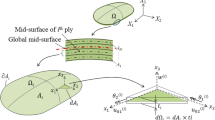Abstract
In this study, we propose a distributed-parametric material orientation optimization method for the optimal design of laminated composite shell structures consisting of anisotropic materials. We consider the compliance as the objective function and minimize it under the state-equation constraint. The material orientation in all the layers is treated as the design variable. The optimal design problem is formulated as a distributed-parameter optimization problem based on the variational method, and the sensitivity function with respect to the material orientation variation is theoretically derived. The optimal orientation variations are determined using the H1 gradient method with Poisson’s equation, where the derived sensitivity function is applied as the fictitious internal heat generation under the Robin condition to reduce the objective function while maintaining a smooth material orientation. With the proposed method, we can conventionally obtain the arbitrary optimal distribution of the material orientations of all the layers of complicated large-scale shell structures like aircraft or automotive bodies without design variable parameterization. The optimal results of the design examples show that the proposed optimization method can effectively obtain the optimal distribution of the material orientation in laminated shell structures.























Similar content being viewed by others
References
Azegami H, Wu ZC (1994) Domain optimization analysis in linear elastic problems: approach using traction method. Trans JSME Ser A 60(578):2312–2318
Azegami H, Kaizu S, Shimoda M, Katamine E (1997) Irregularity of shape optimization problems and an improvement technique. Comput Aided Optimum Des Struct V:309–326
Azegami H, Kaizu S, Takeuchi K (2011) Regular solution to topology optimizationproblems of continua. JSIAM 3:1–4
Bruyneel M (2011) SFP-a new parameterization based on shape functions for optimal material selection: application to conventional composite plies. Struct Multidiscip Optim 43(1):17–27
Gao T, Zhang W, Duysinx P (2012) A bi-value coding parameterization scheme for the discrete optimal orientation design of the composite laminate. Int J Numer Methods Eng 91(1):98–114
Guanxin H, Hu W, Guangyao L (2016) An efficient reanalysis assisted optimization for variable-stiffness composite design by using path functions. Compos Struct 153:409–420
Gürdal Z, Haftka RT, Hajela P (1999) Design and optimization of laminated composite materials. John Wiley & Sons
Hammer VB, Bendsøe MP, Lipton R, Pedersen P (1997) Parametrization in laminate design for optimal compliance. Int J Solids Struct 34:415–434
Honda S, Igarashi T, Narita Y (2013) Multi-objective optimization of curvilinear fiber shapes for laminated composite plates by using NSGA-II. Compos Part B Eng 45(1):1071–1078
Hyer MW, Lee HH (1991) The use of curvilinear fiber format to improve buckling resistance of composite plates with central circular holes. Compos Struct 18(3):239–261
Ikeya K, Shimoda M, Shi JX (2016) Objective free-form optimization for shape and thickness of shell structures. Compos Struct 135:262–275
Kim JS, Kim CG, Hong CS (1999) Optimal design of composite structures with ply drop using genetic algorithm and expert system shell. Compos Struct 46(2):171–187
Kiyono CY, Silva ECN, Reddy JN (2017) A novel fiber optimization method based on normal distribution function with continuously varying fiber path. Compos Struct 160(15):503–515
Kogiso N, Watson LT, Gürdal Z, Haftka RT (1994) Genetic algorithms with local improvement for composite laminate design. Struct Optim 7:207–218
Le RR, Haftka RT (1993) Optimization of laminate stacking sequence for buckling load maximization by genetic algorithm. AIAA J 31:951–956
Miki M (1985) Design of laminated fibrous composite plates with required flexural stiffness. ASTM STP 864:387–400
Nakayama H, Shimoda M (2016) Shape-topology optimization for designing shell structures, Proceedings of ECCOMAS Congress 2016 VII European Congress on Computational Methods in Applied Sciences and Engineering
Nomura T, Dede EM, Matsumori T, Kawamoto A (2015) Simultaneous optimization of topology and orientation of anisotropic material using isoparametric projection method. Proceedings of the 11th WCSMO:7–12
Pederson P (1989) On optimal orientation of orthotropic materials. Struct Optim 1(2):101–106
Shimoda M, Liu Y (2014) A non-parametric free-form optimization method for shell structures. Struct Multidiscip Optim 50:409–423
Shimoda M, Yamane K (2015) A numerical form-finding method for the minimal surface of membrane structures. Struct Multidiscip Optim 51:333–345
Shimoda M, Azegami H, Sakurai T (1998) Traction method approach to optimal shape design problems, SAE 1997 Trans. J Passenger Cars 106:2355–2365
Stegmann J, Lund E (2005) Discrete material optimization of general composite shell structures. Int J Numer Methods Eng 62(14):2009–2027
Suzuki K, Kikuchi N (1991) A homogenization method for shape and topology optimization. Comput Methods Appl Mech Eng 93(3):291–318
Temmen H, Degenhardt R, Raible T (2006) Tailored fiber placement optimization tool. Proceedings of 25th international congress of the aeronautical sciences
Yin L, Ananthasuresh GK (2001) Topology optimization of compliant mechanisms with multiple materials using a peak function material interpolation scheme. Struct Multidiscip Optim 23(1):49–62
Funding
This work was supported by a Grant-in Aid for Scientific Research, Grant Number 18K03853 given by the Japan Society for the Promotion of Science.
Author information
Authors and Affiliations
Corresponding author
Additional information
Responsible Editor: Seonho Cho
Publisher’s Note
Springer Nature remains neutral with regard to jurisdictional claims in published maps and institutional affiliations.
Rights and permissions
About this article
Cite this article
Muramatsu, Y., Shimoda, M. Distributed-parametric optimization approach for free-orientation of laminated shell structures with anisotropic materials. Struct Multidisc Optim 59, 1915–1934 (2019). https://doi.org/10.1007/s00158-018-2163-4
Received:
Revised:
Accepted:
Published:
Issue Date:
DOI: https://doi.org/10.1007/s00158-018-2163-4




